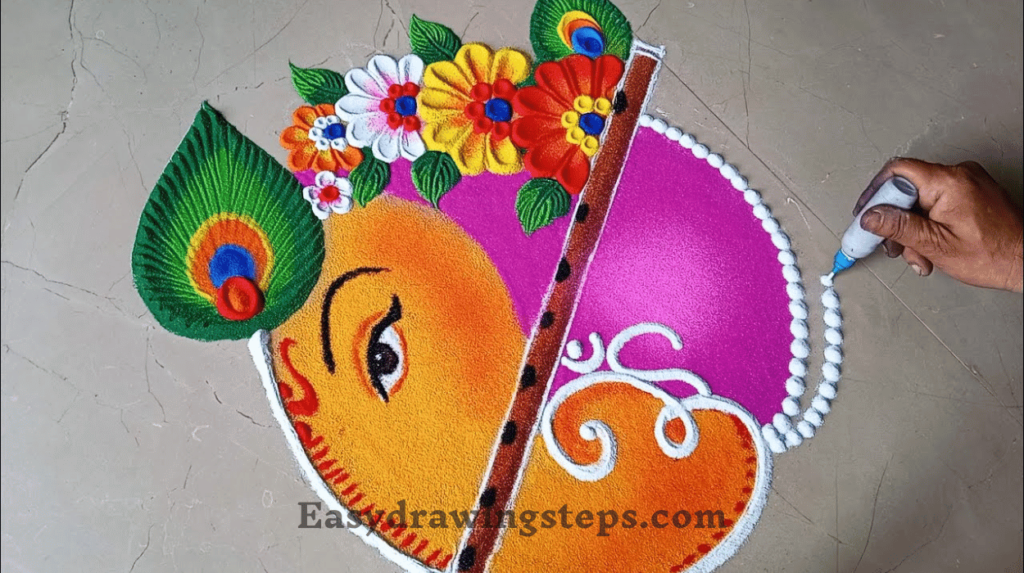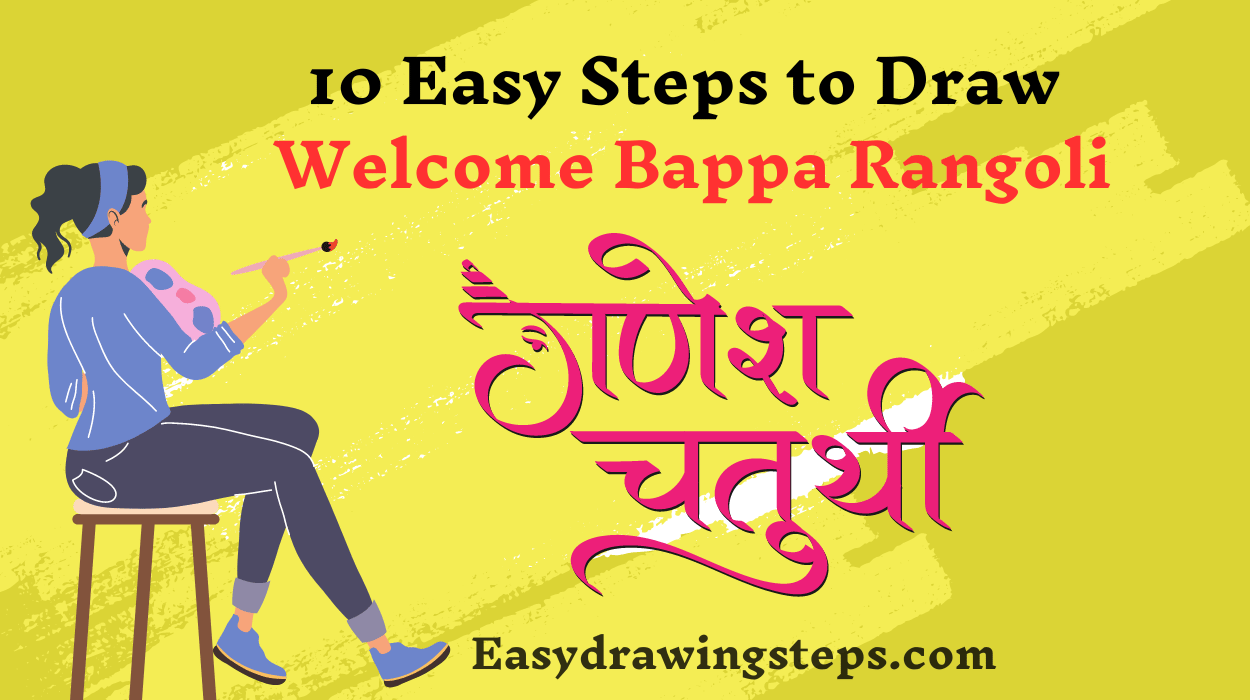Welcome Bappa Rangoli : Rangoli is an exquisite art form that brings vibrancy and joy to any occasion, and what better way to celebrate Ganesh Chaturthi than with a beautifully crafted “Welcome Bappa” Rangoli! Whether you’re a seasoned artist or a beginner, this step-by-step guide will help you create a stunning Rangoli design to welcome Lord Ganesha into your home.
Step 1: Gather Your Materials
Before you start, make sure you have all the materials you need. For a traditional Rangoli, you will require:
- Rangoli colors or colored powders
- White chalk or a pencil for sketching
- A flat surface (floor or a large piece of paper)
- A small brush or your fingers for coloring
- A small sieve (optional, for sprinkling colors evenly)

Step 2: Choose Your Design
Decide on a design that reflects the festive spirit. For a “Welcome Bappa” Rangoli, a simple yet elegant design featuring Lord Ganesha and some traditional motifs is ideal. You can find inspiration from various Rangoli patterns or create your own.
Also Read : 10 Steps to Draw Ganpati Rangoli Easy
Step 3: Sketch the Outline
Start by lightly sketching the outline of your Rangoli on the chosen surface using white chalk or a pencil. Begin with the central image of Lord Ganesha, which can be a simple drawing or a detailed illustration based on your skill level. Surround the central figure with decorative patterns, flowers, and geometric shapes.
Step 4: Define the Borders
Once the basic outline is complete, define the borders of your Rangoli design. This helps to create a clear distinction between different sections of your Rangoli and adds to its overall aesthetic appeal. Use a darker shade or a different color for the borders to make them stand out.

Step 5: Fill in the Colors
Begin filling in the colors within the outlined areas. Use bright, vibrant colors to enhance the festive look. For the central image of Lord Ganesha, you might use shades of orange, pink, or yellow. For the surrounding patterns, choose colors that complement each other and create a harmonious look.
Step 6: Add Details and Highlights
Once the main colors are applied, add details and highlights to make your Rangoli more intricate. You can use contrasting colors to highlight specific areas, add patterns, or create shading effects. This step adds depth and dimension to your Rangoli, making it visually appealing.
Also Read : 10 Steps to Draw Easy Ganpati Rangoli
Step 7: Create a Border Design
To make your Rangoli stand out, create a decorative border around the entire design. This could be a simple pattern of dots, lines, or floral designs. Borders not only frame your Rangoli but also enhance its overall beauty.
Step 8: Add Decorative Elements
For a festive touch, add decorative elements like small flowers, diyas (oil lamps), or glitter. Place these elements strategically around the Rangoli to enhance its appeal and create a festive atmosphere. These small additions can make your Rangoli look more elaborate and celebratory.
Also Read : 10 Easy Steps to Draw Ganpati Rangoli
Step 9: Clean Up the Area
Once you’re satisfied with your Rangoli, clean up the surrounding area to ensure that no stray colors or materials detract from your design. This will help maintain the neatness and visual impact of your Rangoli.
Step 10: Celebrate and Enjoy
Your “Welcome Bappa” Rangoli is now complete! Place it at the entrance of your home or in a prominent area to greet your guests and celebrate Ganesh Chaturthi. Take a moment to admire your work and enjoy the festive spirit it brings.
- Practice Patience: Rangoli is an art form that requires patience. Take your time with each step to ensure a beautiful end result.
- Use Stencils: If you’re new to Rangoli, consider using stencils to help create intricate patterns.
- Experiment with Colors: Don’t be afraid to experiment with different color combinations to find what works best for your design.
- Involve Family and Friends: Rangoli making can be a fun activity to share with family and friends. It adds a personal touch to your celebrations.
Creating a “Welcome Bappa” Rangoli is a wonderful way to honor Lord Ganesha and add a festive charm to your home. Follow these steps, and you’ll have a stunning Rangoli that will surely impress your guests and make your Ganesh Chaturthi celebrations even more special. Happy Rangoli making!
Welcome Bappa Rangoli FAQ
What is the significance of a “Welcome Bappa” Rangoli?
The “Welcome Bappa” Rangoli is created to honor and welcome Lord Ganesha during Ganesh Chaturthi. It symbolizes the arrival of the deity and is meant to bring positivity, prosperity, and good fortune to the household. Rangoli designs are also a way to show devotion and create a festive atmosphere.
Can I use any type of colors for the Rangoli?
While traditional Rangoli colors include vibrant powders made from natural materials, you can use a variety of colors including synthetic Rangoli powders, colored rice, or even flower petals. The key is to use bright and contrasting colors to make the design stand out and enhance its visual appeal.
What if I make a mistake while drawing the Rangoli?
If you make a mistake, don’t worry! You can gently brush away the incorrect parts and start again. Using a small brush or your fingers, you can easily correct mistakes in the design. Alternatively, you can cover the mistake with decorative elements like flowers or diyas to blend it into the overall design.
How can I make my Rangoli last longer?
To make your Rangoli last longer, consider using fixatives or sprays designed for Rangoli colors. Additionally, placing the Rangoli in a dry area away from foot traffic or direct sunlight can help preserve its appearance. If you are using natural materials like flower petals, they should be replaced as needed to maintain the Rangoli’s freshness.
Can I involve my children in making the Rangoli?
Absolutely! Involving children in making Rangoli can be a fun and educational activity. They can help with coloring, filling in patterns, or adding decorative elements. Just ensure that the materials used are safe and suitable for their age. This activity not only fosters creativity but also helps children learn about cultural traditions and festivities.


